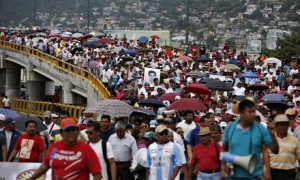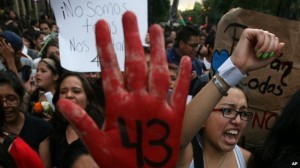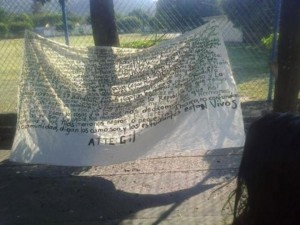
11/02/14 (written by cmolzahn) — The state of Guerrero finds itself in a security crisis following the kidnapping of 43 education students in Iguala near the border with Morelos and Puebla in late September. According to initial reports from survivors of the incident, the students came under fire from police officers on September 26 as they were soliciting public contributions to help them purchase materials necessary for their studies. These hybrid demonstration-fundraisers are said to be relatively common in Guerrero, where students say the state’s education ministry does not sufficiently budget for supplies. Protestors often take possession of busses and trucks in these demonstrations, as was the case in Iguala on September 26, as demonstrators planned to take the march to Mexico City for an October 2 day of protest.
People present took to social media to report the incident, and two and a half hours later a second, unidentified group of gunmen surprised the collection of students, teachers, and reporters following a press conference about the initial incident. A third attack occurred after midnight involving a bus carrying the Los Avispones de Chilpancingo soccer team, leaving the driver and a 15-year old dead, along with a woman traveling in a taxi. In all, six are known to have died in the confrontations including three normalistas, identified as Daniel Solís Gallardo, Yosivani Guerrero, and Julio César Mondragón. It was initially reported that 57 students had been taken by municipal police, apparently financed by a local drug cartel, though 14 were quickly located. The teaching community was reminded of another incident in 2012 when two normalistas from Ayotzinapa, Guerrero died of wounds suffered in an attack from state and federal police as they were demonstrating to demand automatic employment in state schools, among other items.
About a week following the students’ disappearance, six graves were uncovered near where the students were taken containing the remains of 28 bodies, but authorities quickly released a statement that forensic exams demonstrated that they did not belong to the students. Nevertheless, it was this discovery that compelled the federal Attorney General’s Office (Procuraduría General de la República, PGR) to take over the investigation from its state-level counterpart in Guerrero.
There have been numerous arrests in connection with the September 26 attacks and disappearance of the 43 normalistas. On October 17 federal police arrested a man they say is the leader of the drug trafficking organization linked to the incident. Sidronio Casarrubias Salgado, accused of being the leader of the Guerreros Unidos criminal organization, was detained along with an alleged close associate on the highway leaving Mexico City. Guerreros Unidos is one of several groups that splintered from the now-defunct Beltrán Leyva Organization (BLO). Their rival group in the area is Los Rojos, who Casarrubias was told by one of his principal operators was responsible for the September 26 protests. Attorney General Jesús Murillo Karam said that Casarrubias’ arrest would help the investigations into what happened in Iguala to move forward. “I think that the detention [of Casarrubias] that we have today is the first of a new route of investigation that can get us closer to the truth more quickly and easily,” he said the day of the arrest. For his part, Casarrubias has denied giving any order to abduct or kill the students, but rather referred to them as “casualties,” according to Murillo Karam. Moreover, Karam said that Casarrubias admitted to paying municipal police salaries in Iguala, as well as in neighboring Cocula. In all, 36 police officers from Iguala and Cocula have been arrested in connection with the students’ disappearance. Murillo Karam added that 17 members of the Guerreros Unidos organization have also been arrested.

More recently, Former Iguala Mayor José Luis Abarca Velázquez, who was removed from office by order of the Guerrero Senate, was identified along with his wife, María de los Ángeles Pineda Villa, as the ones who ordered the municipal police to first attack the student demonstrators and then detain those remaining and transport them to the municipal police station, where they were allegedly handed over to members of organized crime. These claims, reported by Mexico’s Attorney General’s Office (PGR), originated from Casarrubias Salgado. He indicated that his gang acted against the students on the orders of María de los Ángeles, who was concerned that the protests would “sabotage” a presentation she was to give the same day on women in the workforce. Casarrubias indicated that María de los Ángeles was a “principle operator” of Guerreros Unidos from the municipal offices, alongside her husband and Public Security Secretary Felipe Flores Velázquez. In addition, Attorney General Jesús Murillo Karam alleges that Abarca had paid Guerreros Unidos between $2 and $3 million pesos ($148,000 to $222,000 USD) for their services in the municipality, with $600,000 pesos ($44,489 USD) earmarked for the local police, for which the criminal organization was responsible for staffing. The whereabouts of Abarca and his wife, who has two brothers said to have been accountants for the Beltrán Leyva Organization, are unknown, and they have been deemed fugitives by the Mexican government. Abarca is also wanted in connection with the murder of social activist Arturo Hernández Cardona in May 2013—a crime Abarca has been widely accused of, and which he has denied.
Despite the arrests, demonstrations have broken out in Guerrero and far beyond to demand that authorities do more to locate the missing students. Protests in Guerrero spread to Mexico City on October 7 and then internationally to cities including London, Berlin, and Madrid. Estimates of the Mexico City demonstration ranged from an official number of 15,000 to reports from organizers of 30,000. Family members of the disappeared have been prominent in the aftermath of the disappearance, and parents, siblings, and other relatives of the disappeared joined in the march in Mexico City, which began at the Angel of Independence monument and ended at the Zócalo, the city’s central plaza, where they demonstrated in front of Mexico’s Supreme Court (Suprema Corte de Justicia) and the National Palace (Palacio Nacional). The march was led by members of the national educational workers organization Coordinadora Nacional de Trabajadores de la Educación (CNTE). Meanwhile, protests have continued in Guerrero, including one in the capital city of Chilpancingo where demonstrators lit fire to the state congressional building. Most recently a protest emerged in Acapulco on Friday, October 17, where thousands marched silently, including family members of the disappeared, who carried photographs of the missing students, breaking their silence only to call Governor Aguirre a murderer.
On the federal level, senators from the National Action Party (Partido de Acción Nacional, PAN) have proposed a federal government takeover of functions in Guerrero (desaparición de Poderes), a topic they hope the Senate will address on October 21. If that proposal receives enough votes to pass—Roberto Gil, president of the Justice Committee in the Senate, said that it has the support of 38 PAN senators—Governor Ángel Aguirre will be removed and replaced by a federal appointee. Business owners in the capital Chilpancingo have marched to demand that the Mexican Congress see the measure through.

Meanwhile, the Inter-American Human Rights Commission (Comisión Interamericana de Derechos Humanos, CIDH) has weighed in on the events in Iguala, as well as the apparent execution-style killings of suspected organized crime members by members of the Mexican Army in June in Tlatlaya, in the State of Mexico. CIDH Executive Secretary Emilio Álvarez Icaza said that the two events represent “a significant test for the Mexican state and its institutions.” Tlatlaya and Iguala bring into serious question the veracity of President Enrique Peña Nieto’s public policy, he added. The case of Tlatlaya emerged in the media in September, after a survivor of the incident came forward to claim that the 22 men who died were not killed in a shootout, as the National Defense Ministry (Secretaría de Defensa Nacional, Sedena) had originally reported. An investigation by the Associated Press later revealed evidence that at least eight of them had likely been killed execution-style while unarmed and at close range. Three members of the Army stand accused of homicide and one of covering up facts regarding the case. The secretary’s comments came shortly after the CIDH visited Mexico City regarding the incident in Iguala for a meeting with Interior Minister Miguel Ángel Osorio Chong, Attorney General Jesús Murillo Karam, and President Peña Nieto’s legal advisor. Also present were parents of the disappeared and students. Álvarez Icaza said that it will soon be clear whether or not Mexico will be on the CIDH’s “black list” of troublesome countries appearing in its annual report.
Álvarez Icaza emphasized that Iguala is a case of forced disappearance in which state employees were involved, making the incident even more troubling. In August, the United Nation’s High Commissioner for Human Rights’ Mexico office warned that Mexico faced a “critical situation in the area of disappearance of people.” It called on the Mexican government to recognize the authority of the UN’s Committee on Enforced Disappearances as has been recommended by the UN’s Working Group on Enforced or Involuntary Disappearances, as well as its Human Rights Council have recommended. Human rights advocates also say that forced disappearances have been on the rise in Mexico during the Peña Nieto administration. Ximena Antillón, a researcher at Fundar Analysis Center, said that of the more than 22,000 documented cases over the past two administrations, around 12,500 came during the Calderón administration (2006-2012), while 9,700 have come since Peña Nieto took office in December 2012. If accurate, it would mean that in less than two years the Peña Nieto administration would have accumulated 78% of the forced disappearances that his predecessor accumulated over his six-year administration.
In the meantime, the students remain missing, and investigators have focused the search for them in the area surrounding Iguala, including a garbage dump where human remains were reported to have been found. The investigation has also returned to mass graves that continue to surface nearby, which by October 25 had increased to ten such graves, containing a total of 38 bodies. The Mexican government has brought in Argentinean forensic experts to help identify the remains. On October 30, an undisclosed number of graves containing an additional 14 human remains were then found in the Zitlala and Eduardo Neri municipalities. These had disintegrated to skeletons and showed gunshot wounds to the head, and likely belong to a number of people reported to have disappeared following armed conflicts between the Los Rojos and Los Ardillos gangs. On October 30, a large, handwritten sign (narcomanta) appeared on the Iguala-Taxco highway affirming that the 43 students were alive, and presumably signed by El Gil, one of Guerreros Unidos’ principle leaders. The narcomanta is directed to President Peña Nieto and promises that El Gil will turn himself over to authorities as soon as the 80% of Guerreros Unidos’ leadership structure—which it claims is made up of mayors from northern Guerrero and southern Morelos—is arrested.
Sources:
Pigeonutt, Vania. “Policías atacan a normalistas en Guerrero.” El Universal. September 28, 2014.
“Muerte en Guerrero.” El Universal. September 28, 2014.
“Arrestan a líder narco ligado a desapariciones en Guerrero.” Diario de Yucatán. October 17, 2014.
Mosso, Rubén. “Los Abarca dieron la orden: Murillo.” Milenio. October 23, 2014.
“Alertan en manta que normalistas están vivos.” El Siglo de Torreón. October 31, 2014.




